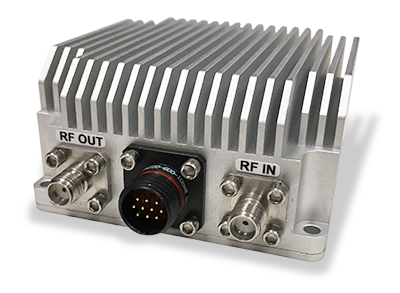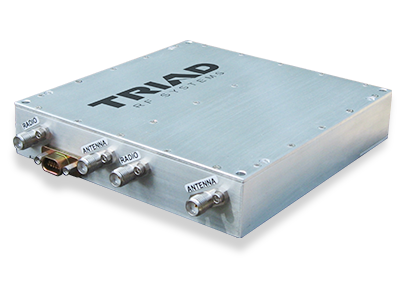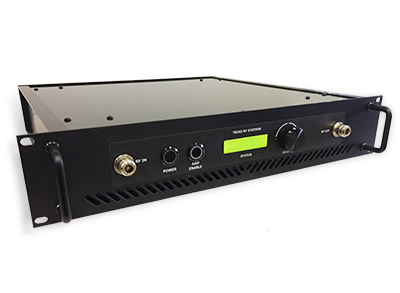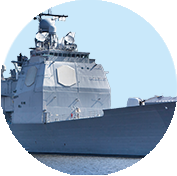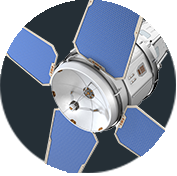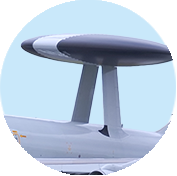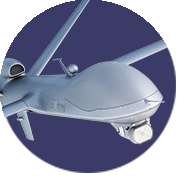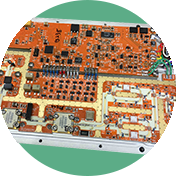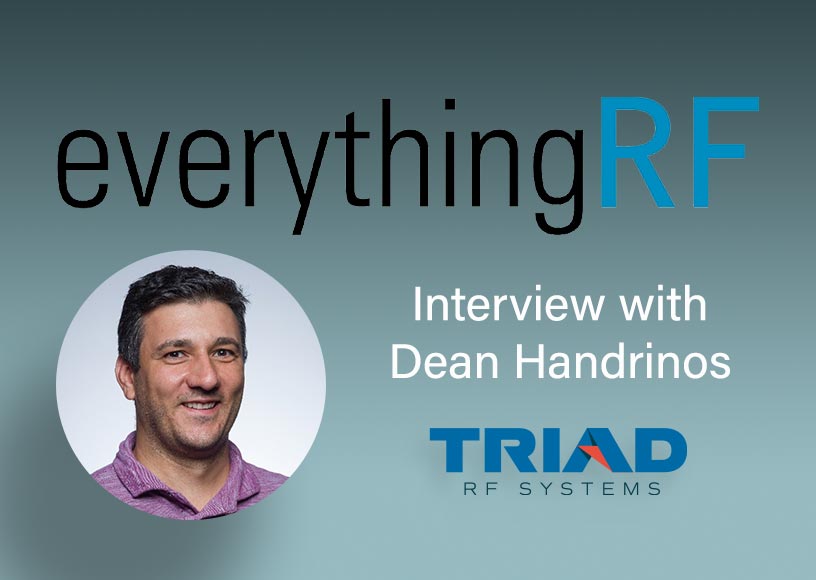
Interview with Dean Handrinos from Triad RF Systems
everything RF recently interviewed Dean Handrinos who is a co-founder and current co-Managing Director at Triad RF Systems. Dean is responsible for setting the strategic direction and management of the Sales, Engineering, and Product Development groups within the organization.
everythingRF: Triad RF Systems is well-known for its work in the defense and aerospace markets. How did Triad first enter the CubeSat market?
Dean Handrinos: Triad has been in business since 2013, when the company was initially founded to bring new thinking around the design of high-power RF systems for Software Defined Radios (SDRs). Triad High Power Radio Systems (THPRs) are commonly integrated into products for military use. The bulk of our experience resides with amplifying MIMO radio systems that have recently become mainstream in the defense space. Designing amplifiers for these systems presents unique challenges and tradeoffs that our engineering team felt they could really take on, and there was clearly a market need for these types of products based on our success so far.
Even though our initial focus and market push was with applications and customers in defense, our products are radio agnostic and can be used for many applications where long-range RF links are necessary for communication or data and sensor information transmission.
This eventually led to companies within the growing commercial space industry ecosystem, including launch service providers, satellite design teams, government research agencies, and others in need of Triad's product solutions for long-range RF links. All of these customers consider Triad a trusted resource and partner in solving difficult radio communication issues including weight restrictions, large bandwidth needs, and energy efficiency.
everythingRF: So, Triad's entry into the CubeSat market wasn't planned from the start?
Dean Handrinos:I would say it was a lucky accident that we had off-the-shelf products that fit into the use case needs of customers within this market. Once we started meeting with these companies and teams, we became very intentional with how we approached the market.
Our first customer in the CubeSat market was actually a launch provider looking to build out and expand their worldwide network of ground tracking stations, enabling better telemetry links with the hundreds of satellites that they manage. That first experience really opened Triad RF up to the possibilities available in this market, as we began to notice that radio links in the CubeSat / SmallSat market faced similar technical challenges that we had spent years solving for our unmanned systems customer base.
Our next opportunity in the CubeSat market came when another company approached us to help design compact, efficient bi-directional amplifiers for their future satellite constellations, after hearing about what we had accomplished with our extremely long-distance ground station bi-directional amplifier capabilities.
I don't want to oversimplify what was actually a pretty intense engineering partnership, but this is where we had the realization that the software-defined radios used in the CubeSat market are very similar to the software-defined radios (SDRs) we already had extensive experience integrating within the military market. That's when we realized there was something here for us and we could help a lot of design teams bridge these tricky communication challenges where failure isn't an option.
Since then, we've shipped thousands of BDAs, power amplifiers, frequency-translating amplifiers, and other RF subsystems for the CubeSat market which have now accumulated a collective 18 years of use in LEO.
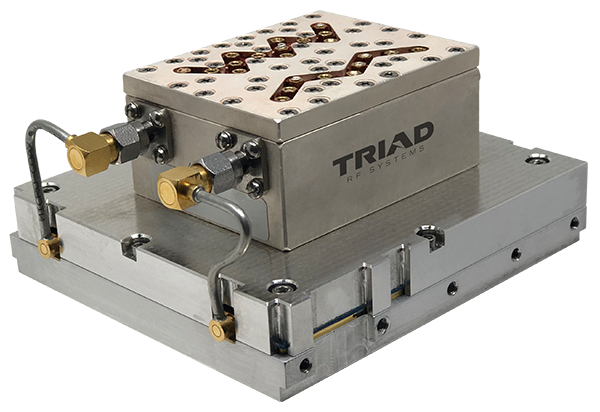
Triad RF Systems bi-directional integrated microwave assembly (IMA) that includes an integrated amplifier and custom radio front end to integrate with Software Defined Radio Systems
everythingRF: What type of products do you specialize in for the CubeSat market? Is the product mix different from the rest of your offerings?
Dean Handrinos: We consider Traid's core specialty as focusing on radio range extension for defense and aerospace applications, in this case satellites.
Even though it looks like a simple straight shot from orbit to a ground receiver, the signal has to travel for hundreds of miles, pass through several distinct layers of the atmosphere, weather phenomena, and a blanket of other RF transmissions that will raise the noise floor for any incoming signals. Our goal is to mitigate these challenges and help CubeSat companies design the best spacecraft they can to complete their mission obligations. We have built a substantial amount of goodwill with these customers; they let us worry about the difficulties of long-range, amplified RF communication. We then design the specific components and subsystems to close the links.
For RF range extension, Triad RF products include power amplifiers and bi-directional amplifiers to help enhance the satellite's RF link budget. Allowing the radio to transmit at a higher power improves signal-to-noise ratios, and helps overcome difficult atmospheric conditions. All of these factors combine to yield comfortable radio link margins, which translate to radio links that simply work, and have high availability.
This is a major simplification of the entire process, but there are tradeoffs that can be made by increasing transmit power, receive sensitivity, using a larger antenna, or utilizing different data modulation techniques. We help our customers understand all of the levers that they can pull to get the best performance out of their system without using excessive power.
Triad RF Mixers and frequency conversion products have been popular as well, allowing satellite systems and radios designed for a specific frequency range to be utilized on a different band. This can be desirable if the radio operates at one frequency but the satellite's radio license is for another band, allowing for one platform to be utilized for different applications as just one cost-saving example. It takes an enormous effort for a satellite vehicle manufacturer to design, qualify, and field a radio system in this market. Our customers avoid starting from scratch when they need to operate in a different band, instead we can design an add-on frequency-translating amplifier module to enhance that existing radio's capability.
We also combine these into complete microwave assembly kits for customers, giving them a single drop-in solution to help manage several related RF subsystems together.
everythingRF: How is designing products for the Cubesat market different from the types of applications you're known for in the defense industry?
Dean Handrinos: There are a few factors that converge together to make things a little more complicated when you're designing for space-based applications.
These include handling the extreme hot and cold cycles the satellite and components will go through as they complete each orbit, and designing systems that can effectively deal with waste heat, radiation hardening, and component life issues. Hardening components against damage from radiation is also a factor for satellites that will be in orbit for decades, as is managing power use and solar generating capacity.
Let's start with waste heat dissipation, as it's one of the unique complicating factors in space. It's much harder to dump excess heat in space than it is within the Earth's atmosphere. Cooling electronics within the atmosphere is achieved through three primary means:
- Conduction, using a physically connected surface like a heat sink to remove waste heat.
- Convection, using airflow or liquid coolers to assist in the removal of waste heat.
- Radiation, where excess heat is converted to infrared energy that is radiated off of the spacecraft.
For ground-based or in-atmosphere airborne applications, simply having a heatsink on the amplifier is often enough to bleed off any excess heat into the air. For applications that generate more heat, the air moving across an exposed heatsink or forced air cooling via fan is enough to keep products at their desired operational temperature range.
Due to the lack of atmosphere in space, conduction and convection are unavailable as there is no air to absorb and transfer away waste heat.
Radiation is the least efficient of these methods but the only one available, so system designers need to think through this when planning the heat load caused by various components of the satellite. Additional complications also arise from the satellite moving through a complete orbital period around the Earth approximately every 50 minutes, exposing the craft to temperature extremes from -60 to 125 degrees C which must also be managed with other environmental inputs and outputs.
Another significant challenge is dealing with the physical size constraints of CubeSats. Size, weight, and power, or as we call it “SWaP”, are the primary considerations. Launching anything into space is costly, and therefore minimizing weight is crucial. CubeSats can range in size from a 4x4 inch cube to something the size of a 20-gallon fish tank. There's a limit to how many solar panels can be added for power and how much battery capacity is available for storage, so power management is another really big focus for us. When the radio and amplifier turn on to transmit, they'll be the most energy-intensive part of the craft. That has to be carefully managed to not only preserve system power for other needs but also to protect other electronics in the system from interference when these are turned on.
everythingRF: Can you expand upon radiation more? Ground robots were sent to explore nuclear accidents such as Fukushima and Chernobyl, only to be disabled by radiation. How is this handled in space?
Dean Handrinos: Thankfully radiation in space isn't nearly as intense as it is inside a nuclear reactor, so it's a much easier problem to deal with.
For larger, long-life satellites such as you'd see with DirectTV or GOES weather systems, they are expected to stay in orbit for many years or even decades in some cases. Those systems will generally have component-level hardening against radiation to ensure long-term survivability.
For CubeSat applications, the mission lifetime and thus the expected product lifetime is much lower, often in the range of just a few months or years. These products are not designed for the same level of radiation as longer-mission length, non-LEO satellites. Radiation mitigation for these products has been very straightforward for our team, and we've developed product testing and screening methods as part of our typical QA process to make sure our parts and subsystems meet our customer's expectations. Parts used in a CubeSat subsystem don't necessarily have to all carry space-grade certifications. However, there is still a fairly involved process in parts selection, via prior LEO flight heritage, or via other means of proving reliability where MIL-STD-883 or MIL-PRF-38534 screening may not be necessary (or doesn't exist) for certain parts.
everythingRF: What are the biggest issues you typically see among CubeSat customers who are trying to think through their RF communication system?
Dean Handrinos: One of the biggest challenges I see customers facing is just how new, relatively speaking, the actual “Cubesat industry” is. The vendor landscape is not fully mature, platform standardization is still underway, and new government organizations and commercial companies are entering the market all the time.
It's really not that dissimilar to the growth we saw in the unmanned systems market over the past decade, when a lot of different companies entered with their own ideas on how to best serve the market. It takes a bit of time for the market to sort out which ideas will gain traction.
So we wind up doing a lot of education with customers and working with them to discover what their actual challenges are, because often the company itself is pretty young and the design team doesn't yet know what they need specific to RF communication.
Another issue is that because the industry is so nascent, sometimes a product solution literally doesn't exist and has to be engineered for a specific use case, so we help walk customers through those issues as well.
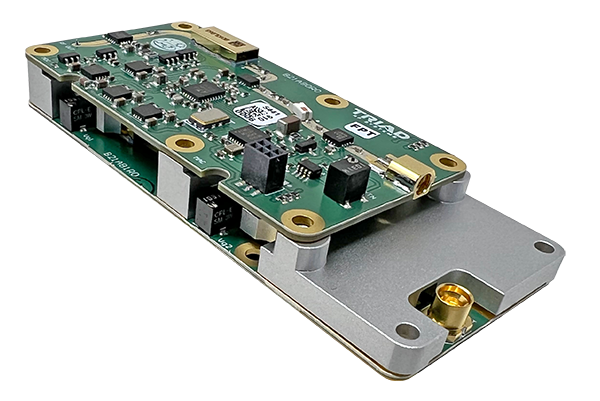
Triad RF Systems Frequency-Translating Amplifier module which converts incoming or outgoing signals from one frequency band to another frequency band used by the Software Defined Radio.
everythingRF: What are the biggest issues you typically see among CubeSat customers who are trying to think through their RF communication system?
Dean Handrinos: Well, the pattern I've noticed started about a decade ago. It reminds me of the early computer age when everyone was trying to find the perfect application for all of this new processing power. We're at a similar stage where we're figuring out what specific functions these devices can best serve.
Companies are finding unique niches for these systems. For example, they're developing ways for oil companies to relay telemetry data from their wells using small pucks and CubeSats. This could present an alternative to more costly, incumbent services like Iridium and Inmarsat.
everythingRF: So, do you think the industry is evolving to shake out and let successful companies emerge?
Dean Handrinos:Absolutely, but while financial aspects can affect the number of players, the industry is also constantly finding new applications. For instance, one of our customers built a network to pick up transponders from ocean-going ships, providing more granular, near-real-time tracking. Another agency was using satellites to enhance weather models by analyzing radio signals passed through cloud formations. Such applications were unknown just a few years ago, or were too expensive to carry out by smaller companies. I think we'll see much more creative thinking as the market continues to mature.
everythingRF:Is there anything else you'd like to share with our readers?
Dean Handrinos: We're thrilled to be part of this growing market and to help our customers turn their systems into reality! If you'd like to discuss your CubeSat needs and challenges with us in more detail please contact our engineering experts.
To read the full article on everythingRF, click here. To learn more about Triad products and services, contact us.
About Dean Handrinos
Dean Handrinos is a co-founder and current co-Managing Director at Triad RF Systems, responsible for setting the strategic direction and management of the Sales, Engineering, and Product Development groups within the organization. Prior to Triad RF Systems, Dean held a number of technical and management roles during his 20-year career in the RF and Microwave industry, including Vice President at Stealth Microwave, Director of US Sales at Anatech Electronics, and Engineer at DCH Systems Inc. Dean holds a Bachelor of Engineering degree from Stevens Institute of Technology, and currently resides in New Jersey with his family.

